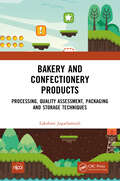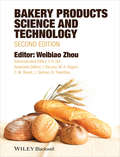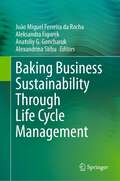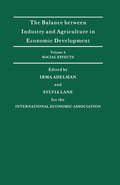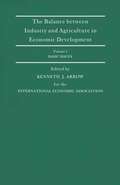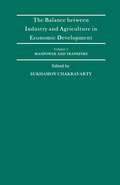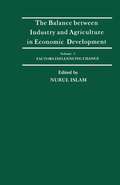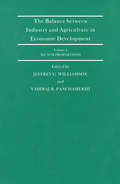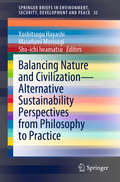- Table View
- List View
Baked to Perfection: Delicious gluten-free recipes with a pinch of science
by Katarina CermeljThe only gluten-free baking book you'll ever need, with delicious recipes that work perfectly every time.From proper crusty bread, pillowy soft cinnamon rolls and glorious layered cakes to fudgy brownies, incredibly flaky rough puff pastry and delicate patisserie – everything that once seemed impossible to make gluten-free can now be baked by you.Baked to Perfection begins with a thorough look at the gluten-free baking basics: how different gluten-free flours behave, which store-bought blends work best, and how to mix your own to suit your needs. Covering cakes, brownies, cookies, pastry and bread in turn, Katarina shares the best techniques for the recipes in that chapter, and each recipe is accompanied by expert tips, useful scientific explanations and occasional step-by-step photography to help you achieve gluten-free perfection.Recipes include classic bakes like super-moist chocolate cake, caramel apple pie and chocolate chip cookies, the softest, chewiest bread, including crusty artisan loaves, baguettes, brioche burger buns and soda bread, and mouth-watering showstoppers like toasted marshmallow brownies, coffee cream puffs and strawberries + cream tart.
Baked to Perfection: Delicious gluten-free recipes with a pinch of science
by Katarina Cermelj'I have nothing against gluten, but this book is just full of recipes I long to make' Nigella LawsonThe only gluten-free baking book you'll ever need, with delicious recipes that work perfectly every single time.From proper crusty bread, pillowy soft cinnamon rolls and glorious layered cakes to fudgy brownies, incredibly flaky rough puff pastry and delicate patisserie – everything that once seemed impossible to make gluten-free can now be baked by you. Baked to Perfection begins with a thorough look at the gluten-free baking basics: how different gluten-free flours behave, which store-bought blends work best, and how to mix your own to suit your needs. Covering cakes, brownies, cookies, pastry and bread in turn, Katarina shares the best techniques for the recipes in that chapter, and each recipe is accompanied by expert tips, useful scientific explanations and occasional step-by-step photography to help you achieve gluten-free perfection. Recipes include classic bakes like super-moist chocolate cake, caramel apple pie and chocolate chip cookies, the softest, chewiest bread, including crusty artisan loaves, baguettes, brioche burger buns and soda bread, and mouth-watering showstoppers like toasted marshmallow brownies, coffee cream puffs and strawberries + cream tart.
Bakery and Confectionery Products: Processing, Quality Assessment, Packaging and Storage Techniques
by Lakshmi JagarlamudiThis book is a comprehensive and practical day-to-day reference for undergraduate and postgraduate students in the discipline of Food Science and Technology. Different topics are discussed to provide a comprehensive knowledge of the theoretical as well as the applied aspects involved in processing of bakery and confectionery products to gain confidence in any dedicated reader to go for a startup in the field. It also covers information on ingredients to bakery and confectionery products, formulae and processes for bakers, equipment for bakers and confectionery units along with quality assessment and standards. It will also help those connected with industries – who supply ingredients, equipment and packaging materials for bakery and confectionery units. The book is also useful for students appearing in any competitive examination in the disciplines of Food Science, Food Science, Nutrition, and Food Technology. This title is co-published with NIPA. Taylor and Francis does not sell or distribute its print and electronic editions in India, Pakistan, Nepal, Bhutan, Bangladesh and Sri Lanka.
Bakery and Confectionery Products: Processing, Quality Assessment, Packaging and Storage Techniques
by Lakshmi JagarlamudiThis book is a comprehensive and practical day-to-day reference for undergraduate and postgraduate students in the discipline of Food Science and Technology. Different topics are discussed to provide a comprehensive knowledge of the theoretical as well as the applied aspects involved in processing of bakery and confectionery products to gain confidence in any dedicated reader to go for a startup in the field. It also covers information on ingredients to bakery and confectionery products, formulae and processes for bakers, equipment for bakers and confectionery units along with quality assessment and standards. It will also help those connected with industries – who supply ingredients, equipment and packaging materials for bakery and confectionery units. The book is also useful for students appearing in any competitive examination in the disciplines of Food Science, Food Science, Nutrition, and Food Technology. This title is co-published with NIPA. Taylor and Francis does not sell or distribute its print and electronic editions in India, Pakistan, Nepal, Bhutan, Bangladesh and Sri Lanka.
Bakery Products Science and Technology
by Weibiao Zhou Y. H. HuiBaking is a process that has been practiced for centuries, and bakery products range in complexity from the simple ingredients of a plain pastry to the numerous components of a cake. While currently there are many books available aimed at food service operators, culinary art instruction and consumers, relatively few professional publications exist that cover the science and technology of baking. In this book, professionals from industry, government and academia contribute their perspectives on the state of industrial baking today. The second edition of this successful and comprehensive overview of bakery science is revised and expanded, featuring chapters on various bread and non-bread products from around the world, as well as nutrition and packaging, processing, quality control, global bread varieties and other popular bakery products. The book is structured to follow the baking process, from the basics, flour and other ingredients, to mixing, proofing and baking. Blending the technical aspects of baking with the latest scientific research, Bakery Products Science and Technology, Second Edition has all the finest ingredients to serve the most demanding appetites of food science professionals, researchers, and students.
Bakery Products Science and Technology
by Weibiao Zhou Y. H. HuiBaking is a process that has been practiced for centuries, and bakery products range in complexity from the simple ingredients of a plain pastry to the numerous components of a cake. While currently there are many books available aimed at food service operators, culinary art instruction and consumers, relatively few professional publications exist that cover the science and technology of baking. In this book, professionals from industry, government and academia contribute their perspectives on the state of industrial baking today. The second edition of this successful and comprehensive overview of bakery science is revised and expanded, featuring chapters on various bread and non-bread products from around the world, as well as nutrition and packaging, processing, quality control, global bread varieties and other popular bakery products. The book is structured to follow the baking process, from the basics, flour and other ingredients, to mixing, proofing and baking. Blending the technical aspects of baking with the latest scientific research, Bakery Products Science and Technology, Second Edition has all the finest ingredients to serve the most demanding appetites of food science professionals, researchers, and students.
Baking Business Sustainability Through Life Cycle Management
by João Miguel Ferreira da Rocha Aleksandra Figurek Anatoliy G. Goncharuk Alexandrina SirbuThis timely and comprehensive text focuses on important recent advances in applied sustainability in the baking industry, connecting all the current methods and strategies into a single book. Those involved in bread production will find the latest developments at the theoretical and practical levels, including information and communication requirements, reporting and regulatory aspects, economic and environmentally sustainable business models, supply chain management, life cycle assessment, product and organizational environmental footprints and more. For small bakery business owners to industry leaders and policymakers, governmental authorities, regulatory authorities and standardization bodies, this book offers a compilation of technical information about sustainability in the market for the bakery sector. Baking Business Sustainability Through Life Cycle Management begins by presenting basic information on the life cycle assessment and product environmental footprint of the bread industry, proposing an analysis of sustainability assessment using environmental and social footprints and providing recommendations for integral optimization of economic and environmental performance. A second section focuses on sustainability in the baking industry, providing a regional focus from Europe to the Americas to Africa and beyond. The third section takes a deep look at economic feasibility and efficiency in the bread industry, including the economic viability of different scenarios for bread-based value chains, and forming efficient business models for bakeries. A final section zeroes in on the most up-to-date innovations in the current bakery industry, including the impact of bakery innovation on business resilience growth, commercial systems, and new business models in regional food systems for farmers and companies, based on multi-actor approach. Innovations within the bakery industry are at an all-time high, with new sustainability and economic models being introduced, along with associated market risks. This timely and ambitious text aims to cover all the most recent advances and methods for successful incorporation into bakery businesses.
Baking Technology and Nutrition: Towards a Healthier World
by Stanley P. Cauvain Rosie H. ClarkA new study of the challenges presented by manufacturing bakery products in a health-conscious world The impact of bakery products upon human nutrition is an increasingly pressing concern among consumers and manufacturers alike. With obesity and other diet-related conditions on the rise, the levels of salt, fat, and sugar found in many baked goods can no longer be overlooked. Those working in the baking industry are consequently turning more and more to science and technology to provide routes toward healthier alternatives to classic cake, bread, and pastry recipes. With Baking Technology and Nutritional Research, renowned food scientist Stanley P. Cauvain and co-author Rosie H. Clark present an innovative and much-needed study of the changes taking place in the world of baking. Their discussion focuses on the new avenues open to bakers looking to improve the nutritional value of their products and encompasses all related issues, from consumer preferences to the effects of nutritional enhancement upon shelf-life. Featuring an abundance of new research and insights into the possible future of modern baking, this unique text: Offers practical guidance on developing, delivering, and promoting high-nutrition bakery products Discusses reducing ingredients such as salt, fat, and sugar for improved nutrition while preserving quality and consumer acceptability Explores how wheat-based products can be ideal vehicles for improving the nutrition of major sectors of populations Suggests real-world solutions to problems rising from poorly defined quality guidelines and inadequate dialogue between bakers and nutritionists Baking Technology and Nutrition is an indispensable and timely resourcefor technologists, manufacturers, healthcare practitioners, or anyone else working in today’s food and nutrition industries.
Baking Technology and Nutrition: Towards a Healthier World (Woodhead Publishing Series In Food Science, Technology And Nutrition Ser.)
by Stanley P. Cauvain Rosie H. ClarkA new study of the challenges presented by manufacturing bakery products in a health-conscious world The impact of bakery products upon human nutrition is an increasingly pressing concern among consumers and manufacturers alike. With obesity and other diet-related conditions on the rise, the levels of salt, fat, and sugar found in many baked goods can no longer be overlooked. Those working in the baking industry are consequently turning more and more to science and technology to provide routes toward healthier alternatives to classic cake, bread, and pastry recipes. With Baking Technology and Nutritional Research, renowned food scientist Stanley P. Cauvain and co-author Rosie H. Clark present an innovative and much-needed study of the changes taking place in the world of baking. Their discussion focuses on the new avenues open to bakers looking to improve the nutritional value of their products and encompasses all related issues, from consumer preferences to the effects of nutritional enhancement upon shelf-life. Featuring an abundance of new research and insights into the possible future of modern baking, this unique text: Offers practical guidance on developing, delivering, and promoting high-nutrition bakery products Discusses reducing ingredients such as salt, fat, and sugar for improved nutrition while preserving quality and consumer acceptability Explores how wheat-based products can be ideal vehicles for improving the nutrition of major sectors of populations Suggests real-world solutions to problems rising from poorly defined quality guidelines and inadequate dialogue between bakers and nutritionists Baking Technology and Nutrition is an indispensable and timely resourcefor technologists, manufacturers, healthcare practitioners, or anyone else working in today’s food and nutrition industries.
The Balance Between Industry and Agriculture in Economic Development: Social Effects (pdf) (International Economic Association Series #Vol. 89)
by Irma Adelman Sylvia LaneThe Balance Between Industry and Agriculture in Economic Development: Proceedings Of The Eighth World Congress Of The International Economic Association, Delhi, India (pdf) (International Economic Association Series)
by Kenneth J. ArrowThe Balance Between Industry and Agriculture in Economic Development: Proceedings Of The Eighth World Congress Of The International Economic Association, Delhi, India: Manpower And Transfers (pdf) (International Economic Association Series #Vol. 88)
by Sukhamoy ChakravartyThe Balance Between Industry and Agriculture in Economic Development: Factors Influencing Change (pdf) (International Economic Association Series #Vol. 90)
by Nural IslamThe Balance Between Industry and Agriculture in Economic Development (International Economic Association Series)
by Vadiraj R. Panchamukhi Jeffrey G. WilliamsonThis volume of papers from the Eighth World Congress deals with changes in proportions and growth rates of sectors of the economy in relation to economic development. It includes a survey of theories of sectoral balance and studies of structural transformation in the Kuznets traditon.
Balanced Automation Systems: Architectures and design methods (IFIP Advances in Information and Communication Technology)
by Luis M. Camarinha-Matos Hamideh AfsarmaneshTowards Balanced Automation The concept. Manufacturing industries worldwide are facing tough challenges as a consequence of the globalization of economy and the openness of the markets. Progress of the economic blocks such as the European Union, NAFTA, and MERCOSUR, and the global agreements such as GATT, in addition to their obvious economic and social consequences, provoke strong paradigm shifts in the way that the manufacturing systems are conceived and operate. To increase profitability and reduce the manufacturing costs, there is a recent tendency towards establishing partnership links among the involved industries, usually between big industries and the networks of components' suppliers. To benefit from the advances in technology, similar agreements are being established between industries and universities and research institutes. Such an open tete-cooperation network may be identified as an extended enterprise or a virtual enterprise. In fact, the manufacturing process is no more carried out by a single enterprise, rather each enterprise is just a node that adds some value (a step in the manufacturing chain) to the cooperation network of enterprises. The new trends create new scenarios and technological challenges, especially to the Small and Medium size Enterprises (SMEs) that clearly comprise the overwhelming majority of manufacturing enterprises worldwide. Under the classical scenarios, these SMEs would have had big difficulties to access or benefit from the state of the art technology, due to their limited human, financial, and material resources.
Balanced Automation Systems II: Implementation challenges for anthropocentric manufacturing (IFIP Advances in Information and Communication Technology)
by Luis M. Camarinha-Matos Hamideh Afsarmaneshxiv box for Balanced Automation, research in this area is still young and emerging. In our opinion, the development of hybrid balanced solutions to cope with a variety of automation levels and manual approaches, is a much more challenging research problem than the search for a purely automatic solution. Various research activities described in this book illustrate some of these challenges through the development proposals, assisting tools, and initial results. In certain chapters however, the balancing aspects are not yet achieved in the research area, but their inclusion in this book is intended to give a broader and more comprehensive perspective of the multiple areas involved. One important aspect to be noticed is the extension and application of the concept of balanced automation to all areas of the manufacturing enterprise. Clearly, the need for a "balanced" approach is not restricted to the shop floor components, rather it applies to all other areas, as illustrated by the wide spectrum of research contributions found in this book. For instance, the need for an appropriate integration of multiple systems and their perspectives is particularly important for the implantation of virtual enterprises. Although both the BASYS'95 and the BASYS'96 conferences have provided important contributions, approaches, and tools for the implantation of balanced automation systems, there are a number of areas that require further research: .
Balanced Control of Flexible Structures (Lecture Notes in Control and Information Sciences #211)
by Wodek GawronskiMethods of structural control and dynamics are introduced in this book. These include reduction of large structural models by balanced truncation, placement of actuators and sensors for dynamic testing and control, structural identification of the minimum-order balanced representation, balanced dissipative controller design, balanced LQG and H( controller designs with the closed-form relationships between controller parameters and system performance, and controller reduction methods that preserve the closed-loop performance. The book explores the unique properties of flexible structures to obtain efficient methods of dynamic analysis and controller design. The presented methods of structural dynamics, identification, sensor/actuator placement, and passive, LQG and H( controller design have been checked both with simulations and industrial implementations.
Balanced Microwave Filters (Wiley - IEEE)
by Ferran Martin Lei Zhu Jiasheng Hong Francisco MedinaThis book presents and discusses strategies for the design and implementation of common-mode suppressed balanced microwave filters, including, narrowband, wideband, and ultra-wideband filters This book examines differential-mode, or balanced, microwave filters by discussing several implementations of practical realizations of these passive components. Topics covered include selective mode suppression, designs based on distributed and semi-lumped approaches, multilayer technologies, defect ground structures, coupled resonators, metamaterials, interference techniques, and substrate integrated waveguides, among others. Divided into five parts, Balanced Microwave Filters begins with an introduction that presents the fundamentals of balanced lines, circuits, and networks. Part 2 covers balanced transmission lines with common-mode noise suppression, including several types of common-mode filters and the application of such filters to enhance common-mode suppression in balanced bandpass filters. Next, Part 3 examines wideband and ultra-wideband (UWB) balanced bandpass filters with intrinsic common-mode suppression. Narrowband and dual-band balanced bandpass filters with intrinsic common-mode suppression are discussed in Part 4. Finally, Part 5 covers other balanced circuits, such as balanced power dividers and combiners, and differential-mode equalizers with common-mode filtering. In addition, the book: Explores a research topic of increasing interest due to the growing demand of balanced transmission lines and circuits in modern communication systems Includes contributions from prominent worldwide experts in the field Provides readers with the necessary knowledge to analyze and synthesize balanced filters and circuits Balanced Microwave Filters is an important text for R&D engineers, professionals, and specialists working on the topic of microwave filters. Post graduate students and Masters students in the field of microwave engineering and wireless communications, especially those involved in courses related to microwave filters, and balanced filters and circuits will also find it to be a vital resource.
Balanced Microwave Filters (Wiley - IEEE)
by Ferran Martin Lei Zhu Jiasheng Hong Francisco MedinaThis book presents and discusses strategies for the design and implementation of common-mode suppressed balanced microwave filters, including, narrowband, wideband, and ultra-wideband filters This book examines differential-mode, or balanced, microwave filters by discussing several implementations of practical realizations of these passive components. Topics covered include selective mode suppression, designs based on distributed and semi-lumped approaches, multilayer technologies, defect ground structures, coupled resonators, metamaterials, interference techniques, and substrate integrated waveguides, among others. Divided into five parts, Balanced Microwave Filters begins with an introduction that presents the fundamentals of balanced lines, circuits, and networks. Part 2 covers balanced transmission lines with common-mode noise suppression, including several types of common-mode filters and the application of such filters to enhance common-mode suppression in balanced bandpass filters. Next, Part 3 examines wideband and ultra-wideband (UWB) balanced bandpass filters with intrinsic common-mode suppression. Narrowband and dual-band balanced bandpass filters with intrinsic common-mode suppression are discussed in Part 4. Finally, Part 5 covers other balanced circuits, such as balanced power dividers and combiners, and differential-mode equalizers with common-mode filtering. In addition, the book: Explores a research topic of increasing interest due to the growing demand of balanced transmission lines and circuits in modern communication systems Includes contributions from prominent worldwide experts in the field Provides readers with the necessary knowledge to analyze and synthesize balanced filters and circuits Balanced Microwave Filters is an important text for R&D engineers, professionals, and specialists working on the topic of microwave filters. Post graduate students and Masters students in the field of microwave engineering and wireless communications, especially those involved in courses related to microwave filters, and balanced filters and circuits will also find it to be a vital resource.
Balanced Phono-Amps: An Extension to the 'The Sound of Silence' Editions
by Burkhard VogelThis extensively reworked 2nd edition of the book includes ten new chapters. It also features an updated discussion of simulation software tools, covering topics such as simulating complex and / or expensive amplifier structures with the free LTspice software by developing a broad range of additional simulation models, especially those for triodes and transformers.The book adopts the structure used in The Sound of Silence books, with the first part, Basics - Calculations and Simulations, providing deep simulation-triggered insights into the gain and noise mechanisms of differential amplifiers, BJTs, resistors, and triodes. The second part then discusses the RIAA Phono-Amp Engine II, describing all the necessary design, simulation, calculation, construction and measurement processes for this multi-functional MC amplifier.The third part, Knowledge Transfer, presents new ideas on draft designs of the linear low-noise MC input stages (also an extremely low-noise one) and a range of practical measurement tools. Additionally, it includes a chapter on MM amplifiers and their noise production, and offers some surprising solutions. The brand new and extensive chapter on all the simulation models developed and used in the book rounds-out the voyage through the jungle of compromises, allowing best-in-class balanced MC phono-amplifiers to be produced.Lastly, the book also features an extensive index, and free downloads of all Mathcad worksheets are available on Springer's Extra Materials website (extra.springer.com).
Balanced Phono-Amps: An Extension to the 'The Sound of Silence' Editions
by Burkhard VogelThis book presents the design, analysis and testing of fully balanced RIAA phono amps and measurement tools. The content of this book extends a standard reference about RIAA phono amps “the sound of silence” by Burkhard Vogel. Here, the gap is filled between a semi-balanced engine (RIAA Phono-Amp Engine I) and a fully balanced engine, the RIAA Phono-Amp Engine II. In this new book on hand, “fully balanced” means that each phono-amp stage ends up in a balanced - or in other words symmetrical - solution, differentially amplified. Un-balanced / single-ended solutions are not in the scope.
Balances: Instruments, Manufacturers, History
by Erich Robens Shanath Amarasiri Jayaweera Susanne KieferThe book deals mainly with direct mass determination by means of a conventional balances. It covers the history of the balance from the beginnings in Egypt earlier than 3000 BC to recent developments. All balance types are described with emphasis on scientific balances. Methods of indirect mass determination, which are applied to very light objects like molecules and the basic particles of matter and celestial bodies, are included. As additional guidance, today’s manufacturers are listed and the profile of important companies is reviewed. Several hundred photographs, reproductions and drawings show instruments and their uses. This book includes commercial weighing instruments for merchandise and raw materials in workshops as well as symbolic weighing in the ancient Egyptian’s ceremony of ‘Weighing of the Heart’, the Greek fate balance, the Roman Justitia, Juno Moneta and Middle Ages scenes of the Last Judgement with Jesus or St. Michael and of modern balances. The photographs are selected from the slide-archives of the late Richard Vieweg (1896-1972) (former President of the Physikalisch-Technische Bundesanstalt, Braunschweig, Germany), of the late Hans R. Jenemann (1920-1966) (former head of the Analytical Laboratory of Schott & Gen., Mainz, Germany) and of his wife Irene (1933-2008) and of Erich Robens.
Balancing Nature and Civilization - Alternative Sustainability Perspectives from Philosophy to Practice (SpringerBriefs in Environment, Security, Development and Peace #32)
by Yoshitsugu Hayashi Masafumi Morisugi Sho-Ichi IwamatsuThis book is an outcome of an international symposium: Sustainability –Can We Design the Future of Human Life and the Environment? which was held as a satellite event of the “Love the Earth”-Expo 2005 (Aichi, Japan). Each chapter is based on the lecture given by the following eminent researchers: Yoshinori Ishii, Hans-Peter Dürr, Yoshinori Yasuda, Minoru Kawada, Yasunobu Iwasaka, Werner Rothengatter, Hisae Nakanishi, Yang Dongyuan, Lee Schipper, Itsuo Kodama, and Yoshitsugu Hayashi.In the Part I titled “A Sustainable Relationship between Nature and Humans”, we discuss what will become of fossil fuels and petroleum, and what kind of indicators should be used to monitor the energy expended by human society. We then discuss environmental impacts caused by different civilizations and values on Nature and ethics, based on the perspective of environmental archaeology and on the discussions by Kunio Yanagita, the father of Japanese folklore study.The Part II is titled and shows “International Conflict Concerning Environmental Damage and Its Causes”. The Asian dust (Kosa) is a typical example of transboundary conflicts between nations. Another example can be found in the EU’s attempt to put in place a common motorway toll system across EU countries having different geographical and economic conditions. Finally, Part III covers the opinions and further debates on sustainable future earth based on the lectures in Parts I and II.We hope that great insights in this book will come across to readers, and be of help in steering the world towards a sustainable society in harmony with biosystems on earth.
Balancing of High-Speed Machinery (Mechanical Engineering Series)
by Mark S. DarlowModern rotating machinery, particularly turbomachinery, is frequently being designed to operate at higher speeds than in the past. Consequently, there is an increased need to balance high-speed rotors. The purpose of this book is to provide the engineering student or practicing engineer with a single, complete reference on high-speed rotor balancing. To this end, a detailed analytical background and practical application procedures are presented for each of the principal high-speed rotor balancing methods, i.e. modal balancing, influence coefficient balancing and the Unified Balancing Approach. This information is supplemented and supported through a presentation of the theoretical development of synchronous rotor vibration and a brief overview of rigid rotor balancing techniques and machines. This is the first time this material is available in a single, concise volume, together with detailed descriptions of application procedures.
Balancing of Linkages and Robot Manipulators: Advanced Methods with Illustrative Examples (Mechanisms and Machine Science #27)
by Vigen Arakelian Sébastien BriotIn this book advanced balancing methods for planar and spatial linkages, hand operated and automatic robot manipulators are presented. It is organized into three main parts and eight chapters. The main parts are the introduction to balancing, the balancing of linkages and the balancing of robot manipulators. The review of state-of-the-art literature including more than 500 references discloses particularities of shaking force/moment balancing and gravity compensation methods. Then new methods for balancing of linkages are considered. Methods provided in the second part of the book deal with the partial and complete shaking force/moment balancing of various linkages. A new field for balancing methods applications is the design of mechanical systems for fast manipulation. Special attention is given to the shaking force/moment balancing of robot manipulators. Gravity balancing methods are also discussed. The suggested balancing methods are illustrated by numerous examples.


